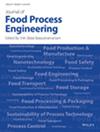Assessment of different kinetic models for the production of fructo-oligosaccharides through enzymatic synthesis
Abstract
Mathematical modeling is a great tool to understand the mechanism of fructo-oligosaccharides (FOS) synthesis. The objective in this work is to adapt different models designed for FOS synthesis. Two approaches for the reaction mechanism, chain reaction and ping-pong, were included in the analysis and genetic algorithm was implemented to find the best fit. Both approaches offered good results, chain reaction approach showed lower overall relative errors (below 8.5%) while ping-pong mechanism best fit presented an overall error of 10.5%. No matter the approach used, the models with best fit involved the concept of glucose inhibition for the transfructosylation reaction. Different objective functions can be tested to reduce the relative errors when the model struggled to describe the behavior of one component. The sensitive analysis helps to evaluate all the variables such as reaction rate, time, productivity, and FOS yield, to find an optimal reaction condition.
Practical applications
This research aims to describe and help understand the reaction mechanism involved in the enzymatic synthesis of fructo-oligosaccharides, through the study of the kinetics using different mathematical models found in the consulted bibliography. This way, the operational conditions (substrate type and concentration, enzyme source [bacteria or fungi], enzyme configuration [purified or whole cells, free or immobilized], enzyme/substrate ratio, reaction time, temperature, and pH, batch or continuous mode) can be adapted, ensuring the attainment of the desired final product.

 求助内容:
求助内容: 应助结果提醒方式:
应助结果提醒方式:


